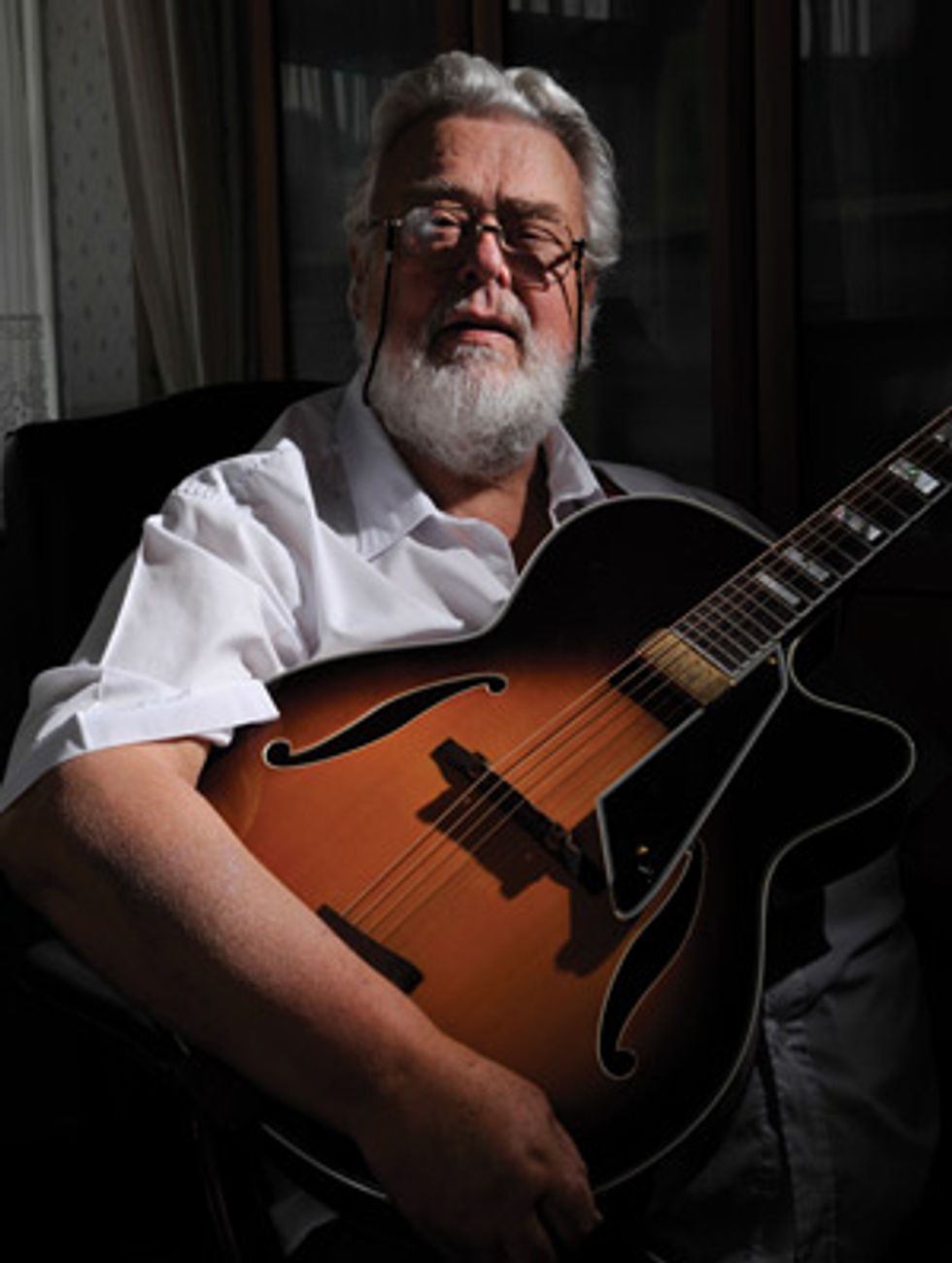
Born: February 14, 1941
Died: October 2, 2012
Best Known For: Along with Jimmy Page, Sullivan was arguably the top U.K. recording-session guitarist in the 1960s. He played on more than 50 No. 1 hits by the Kinks, David Bowie, Dusty Springfield, Eddie Cochran, and many, many others.
Throughout the King of Rock and Roll’s career, Elvis Presley amassed 18 No. 1 hit singles. The Beatles went even further, claiming the top spot on the charts a staggering 27 times in America and Great Britain. The two aforementioned achievements are incredible and reflect the popularity and dominance both the King and the Fab Four had over the world of music in their respective eras. Which puts this month’s Forgotten Hero into quite a perspective: With contributions made on 55 No. 1 hits under his belt—and an estimated 1,000 Top 10 hits overall—neither Elvis, The Beatles, or anyone else in the history of popular music can touch English session guitarist Big Jim Sullivan in terms of sheer commercial success. With his recent passing last October 2, 2012, still fresh in our minds, we pay tribute to a fretboard legend who came of age alongside a young Jimmy Page, and wound up supporting Tom Jones for many years in Vegas.
One Wild Cat
Big Jim Sullivan was born as James
George Tomkins on February 14, 1941, in
Uxbridge, Middlesex, England. His mother
died when he was just 2 years old, and his
grandparents raised him until he moved
in with his aunt and uncle as a teenager.
Sullivan first picked up the guitar at age 14,
and like many fledgling, young guitarists
around England, it was the music emanating
from America that captured his heart.
“It was the early days of rock ’n’ roll in this
country,” Sullivan remembered on his website.
“We were all struggling to learn music;
it might be country, jazz, classical, blues,
or even rock ’n’ roll. None of us younger
musicians wasted too much time doing
teenage things.”
In 1956, Sullivan had been playing guitar only a year when he was invited to join a band called The Soho Group. The group played mostly coffee houses around London such as the Troubadour at Earl’s Court and the Two I’s to small crowds of mostly fellow musicians. It was at the Two I’s that Sullivan first ran into Marty Wilde front man for the up-and-coming group, The Wildcats. Wilde was impressed with Sullivan’s playing and asked his drummer and bassist to inquire whether Sullivan might be interested in joining up with them. Sullivan was interested and played with the The Wildcats all across England, including opening up for rock legends Eddie Cochran and Gene Vincent for a number of dates. “The Wildcats were at home with Eddie on and off the stage,” Sullivan once said. “Although he was only 21 himself, we looked up to him as a guide. He used to amaze us with his dexterity, both in country and blues.”
It was around this time that Big Jim ran into future Deep Purple guitarist Ritchie Blackmore and decided to take him under his wing and teach him a thing or two about how to play guitar. “I first met Jim Sullivan in 1958,” Blackmore recalled in Classic Rock magazine after Sullivan’s untimely passing. Both guitarists lived in Middlesex, Cranford, and were introduced by the brother of Blackmore’s sister-in-law. “He showed me another level of playing,” Blackmore continued. “He was probably the most advanced guitarist in the London area.”
On his website, Sullivan commented on the inherent ability of his young pupil. “Ritchie was a precocious talent even then, he learned to be an individual very quickly. To be truthful, I think that telling him to be an individual and making him use his little finger is all I needed to tell him. The rest was natural to him.”
In 1958, Sullivan entered the recording studio for the first time to lay down some tracks with The Wildcats. In anticipation of these sessions, Wilde gave Jim a new guitar to play, a 1955 goldtop Gibson Les Paul, thought to be the first Les Paul in England.
“It belonged to a gospel singer called Sister Rosetta Tharpe,” Sullivan recalled. “Marty bought it from her in the mid ’50s. I used this guitar until 1959 when American guitars were allowed to be imported into this country.”
He went to Ivor Mairants Musicentre in London and laid down £300 on a cherry-red 1958 Gibson ES-345, which became his main axe throughout the early ’60s. In 1965, Sullivan decided to part ways with this guitar and sold it for £200 to Johnny Hallyday’s lead guitarist. It was around this time that Sullivan began a long endorsement period with Rickenbacker and used a variety of their guitars throughout the rest of the 1960s and ’70s.
The Wildcats quickly found great success in England producing five Top 10 singles from 1958-1959, including “Endless Sleep,” “Donna,” “A Teenager in Love,” “Sea of Love,” and “Bad Boy.” The group was produced in the studio by acclaimed producer Jack Good who was quick to notice Sullivan’s guitar-playing ability and began using him as a session musician on tracks for other artists from then onward.
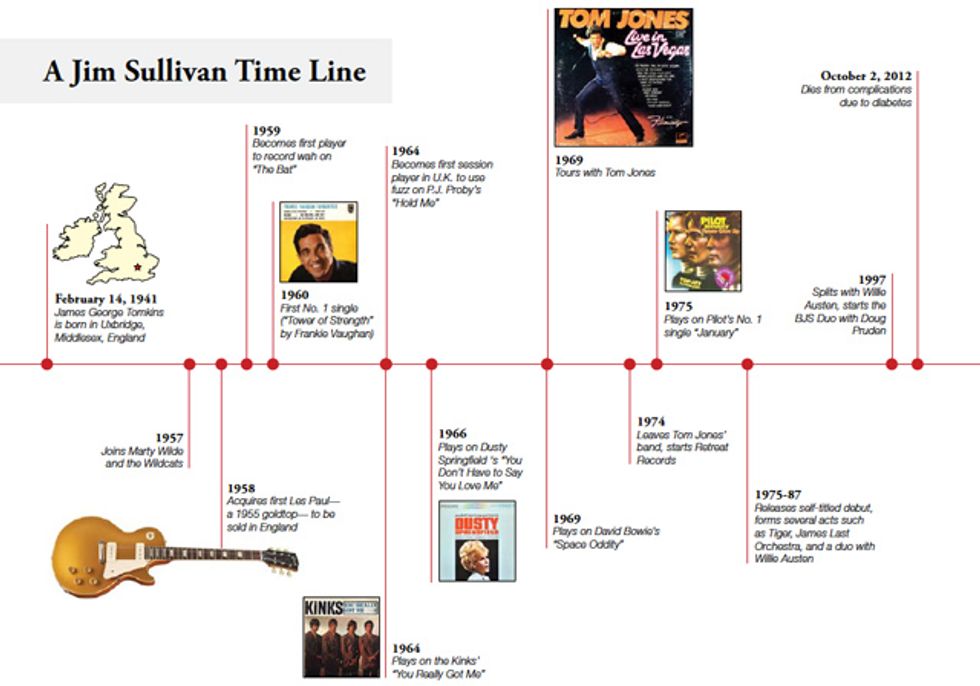
Secret Sessions
The music industry had a big secret in the
1950s and ’60s. The group you loved so
much who played that song you can’t stop
listening to … they didn’t actually play it.
If session musicians were the unspoken
reality of the music business, then Big
Jim Sullivan would become its greatest
secret of all. The reasons why session
musicians were favored in the recording
studio over the act whose name would
appear on the record label were varied;
among them were consistency, natural
talent, or even something as basic as fear.
The studio environment can be a very
stressful setting, as Sullivan himself would
later admit. “Most of the groups couldn’t
handle the studio, it was a very nerve-racking
experience if you never worked in
studio conditions before,” he wrote on his
website. “You sit there waiting for the red
light to go on. You could be sitting there
for five minutes, waiting, while the producer
talks to the engineer. Then the light
goes on and you know that you mustn’t
make a mistake for at least 4 minutes, if
you can’t control your nerves you fold and
make mistakes.”
Whatever the reason was to use a session musician, Big Jim Sullivan quickly proved himself to be quite well suited to the recording environment and was highly sought-after for his services. Shel Talmy, who produced sessions for The Kinks and The Who in the early 1960s, would later say, “At that time in London, there were very few really current musicians—a lot of good musicians, but kind of mired slightly in the past. There was like one or two good rhythm sections and that was it. I originally started using Big Jim Sullivan who was the only one.”
Sullivan was truly the new kid in town in more ways beside his recent arrival into the session world. Many of the older established players in the community were essentially unaccustomed to the young guitarist’s style of playing. The older session men called him the “Electric Monster” because he used to make the guitar scream and groan when he bent and pulled the strings.
Sullivan was truly an innovator and one of the first players around the U.K. to use innovative new technologies, such as effects pedals, to change the sound of the guitar. Blackmore said in Classic Rock that Sullivan was the first guitarist to play through a wah-wah pedal. “It was a DeArmond foot volume and tone control. I remember an instrumental called ‘The Bat’ where he used the pedal. That would’ve been around 1959.”
Sullivan was an early trailblazer in the use of fuzz pedals as well, and he recalled on his website the first time he ever used one. “Eric Ford came to a session one day and produced this little gold box with Gibson written on it. It had one button for off and on, and he wasn’t quite sure about what it did. I knew what it was because I knew Chet Atkins had used such a gizmo on one of the Everly Brothers tracks. Eric lent it to me and I used it on the track we were recording at the time. It blew the mind of Keith Grant, the engineer at Olympic studios, and we only did one take of that particular track.” That particular track Sullivan referred to was called “Hold Me” by singer P.J. Proby and would ultimately reach No. 3 on the U.K. pop charts. After that session, Big Jim Sullivan was the most sought-after lead guitar player in England.
Big Jim Sullivan was an early innovator of the fuzz and wah effects, using
the former in a 1964 P.J. Proby track, and the latter in Dave Berry’s “The
Crying Game.”
Hallmarks of Sullivan's Style
Throughout his career as a session guitarist, Big Jim Sullivan has played every type of style one can imagine. If you were to listen to just the 55 No. 1 hits under his belt, the vast array of tones he captured is truly astounding. Sullivan’s biggest contributions to popular music, however, were made in the field of rock ’n’ roll. When Sullivan first entered the session world, the older session musicians who were unfamiliar with the young guitarist’s dynamic style referred to him as the “Electric Monster.”
Big Jim was one of the true innovators of fuzz tone and was one of the first to use it on record for the P.J. Proby single “Hold Me” in 1964. Sullivan had been booked for the Proby session along with fellow guitarist Eric Ford who came in with a Gibson Maestro fuzz box. Sullivan immediately recognized what Ford had and asked if he might borrow it. Ford consented, and after playing around with it a bit, Big Jim was able to dial in a truly new and unique tone that he liked and thought sounded good for the song.
For a majority of the track Sullivan is playing mild palm-muted chords along with the rest of the band until a descending drum roll mid-way through the song. At this point, he becomes completely unleashed, and the result is a fiery fuzz-filled guitar solo that blew the minds of all those present and ended up catapulting the song to No. 3 on the U.K. charts. With the release of “Hold Me,” guitarists all around England quickly took note of the new sonic possibilities contained within the fuzz box, and soon notables such as Keith Richards, Jeff Beck, and Eric Clapton were using fuzz boxes.
Sullivan also was one of the earliest known users of the mighty wah pedal. In 1965, Sullivan sat in on a session with pop singer Dave Berry for a track titled “The Crying Game.” The session itself is one of many that Sullivan would play with an unknown Jimmy Page who held down the rhythm guitar duties for this particular recording. The song is a slow-tempo ballad with Sullivan providing echoing guitar licks behind Berry’s soulful vocal delivery. Each lick is essentially a repeat of the previous vocal line with the wah effect added to simulate the sound of a warble in someone’s voice overcome with emotion.
Sullivan knew that he might be called into the studio to play guitar in virtually every genre and style. Any given day of any given week he might play a rock song in the morning, a jazz track in the afternoon, and maybe a country number in the evening. The true mastery and genius of Big Jim Sullivan was his ability to provide what was needed for the session, while at the same time delivering exciting and new guitar parts that pushed the envelope and grabbed the ear.
Studio Gold
As the 1950s faded into the 1960s, and
pop and rock music began to dominate the
charts, Sullivan found himself called upon
to fill in on recording sessions increasingly
more often.
“The guitar was very popular at this time during the ’60s and almost every session had at least two guitars on them,” Sullivan wrote of the shift. “Folk music was popular and so was country, but the Memphis sound was being overtaken by the Stax and Motown sound. The late-mid ’60s had the groups taking over the charts. The solo artist was still around, but groups were in the studios and most of my work was with them.”
Generally speaking, a typical workload for Sullivan during this period would require him to play on up to three separate sessions per day, seven days a week. There was a lot of work, and in one day the best session guitarists of that time found themselves doing a country track in the morning, followed by an afternoon of pop or rock ’n’ roll, then later contributing guitar licks to a symphony orchestra.
Sullivan played with Nancy Sinatra, Jerry Reed,
John Denver, and others on This Is Tom Jones, a
TV variety show that aired on ABC from 1969-71.
Photo courtesy of ABC Photo Archives/Getty
Big Jim Sullivan wasn’t always known as “Big Jim.” It was the entrance of a young man named James Patrick Page into the session world that necessitated the nickname in order to differentiate one Jim from the other. “I’ll always remember the first time I met Jimmy [Page],” Sullivan recalled. “We had a session at Decca Studios for Dave Berry. It was the session for ‘My Baby Left Me’ and Jimmy played lead guitar and I played rhythm. I remember the great solo that he did on that session— it is one of the best constructed rock solos on record.”
After that first session, Sullivan and Page would go on to play together numerous times and became fast friends. “The amount of recordings we did together was amazing, and when he said he and John [Paul Jones] were going to leave, he said I should join them too.” History holds that Sullivan did not join the two members of Led Zeppelin, however, he did loan Page a Gibson J-200 acoustic that Page used extensively on the first two Led Zeppelin albums.
It was during the fertile music period of the mid-1960s that Big Jim contributed guitar parts to literally hundreds of singles that reached into the Top 10 on the charts, including 55 that climbed all the way to No. 1. Among the many, many hits he played on, some of the standouts include “It’s Not Unusual” by Tom Jones, “Downtown” by Petula Clark, “Space Oddity” by David Bowie, “Goldfinger” by Shirley Bassey, “You Really Got Me” by The Kinks, and “Itchycoo Park” by the Small Faces.
This is just a very small sampling of the tracks Sullivan played on, and to this day there is still contention about what songs he may or may not have contributed to, but as Sullivan himself said in an interview: “If I could remember the 60,000-odd artists that came through the studios over the 30-odd years that I played on sessions, I would be a walking encyclopedia and would never get any sleep.”
Unusual Company
“I think I had more experience of life in the
five years working with Tom [Jones] than
I did all the rest of my life put together,”
Big Jim said in 2006. In 1969, after spending
more than a decade in the recording
studio, Big Jim Sullivan decided to hit the
road to support Tom Jones—on tour, and
then later for his residency in Las Vegas and
on his subsequent television show. Sullivan
was most likely burned out from the huge
demands placed on him by the recording
industry. “We were doing three sessions a
day, day in and day out,” he wrote. “I never
had a Christmas at home for about 10
years. I also never had a holiday for years.”
During his time in Las Vegas, Sullivan
came face to face with a personal hero of
his: Elvis Presley. After their initial meeting
where, according to Sullivan, they “sat up
for a couple of days chatting and drinking,”
the two men struck up a real friendship that
lasted until Presley’s death in 1977.
Sullivan played with Jones for five years, while at the same time recording and releasing three studio albums under his own name: Sitar Beat, on which he played the sitar, an album of Gilbert O’Sullivan songs called Sullivan Plays O’Sullivan, and Big Jim’s Back in 1974. Sullivan didn’t experience much in the way of success with his solo endeavors and once called Big Jim’s Back “the biggest embarrassment” of his life because he had to sing on it.
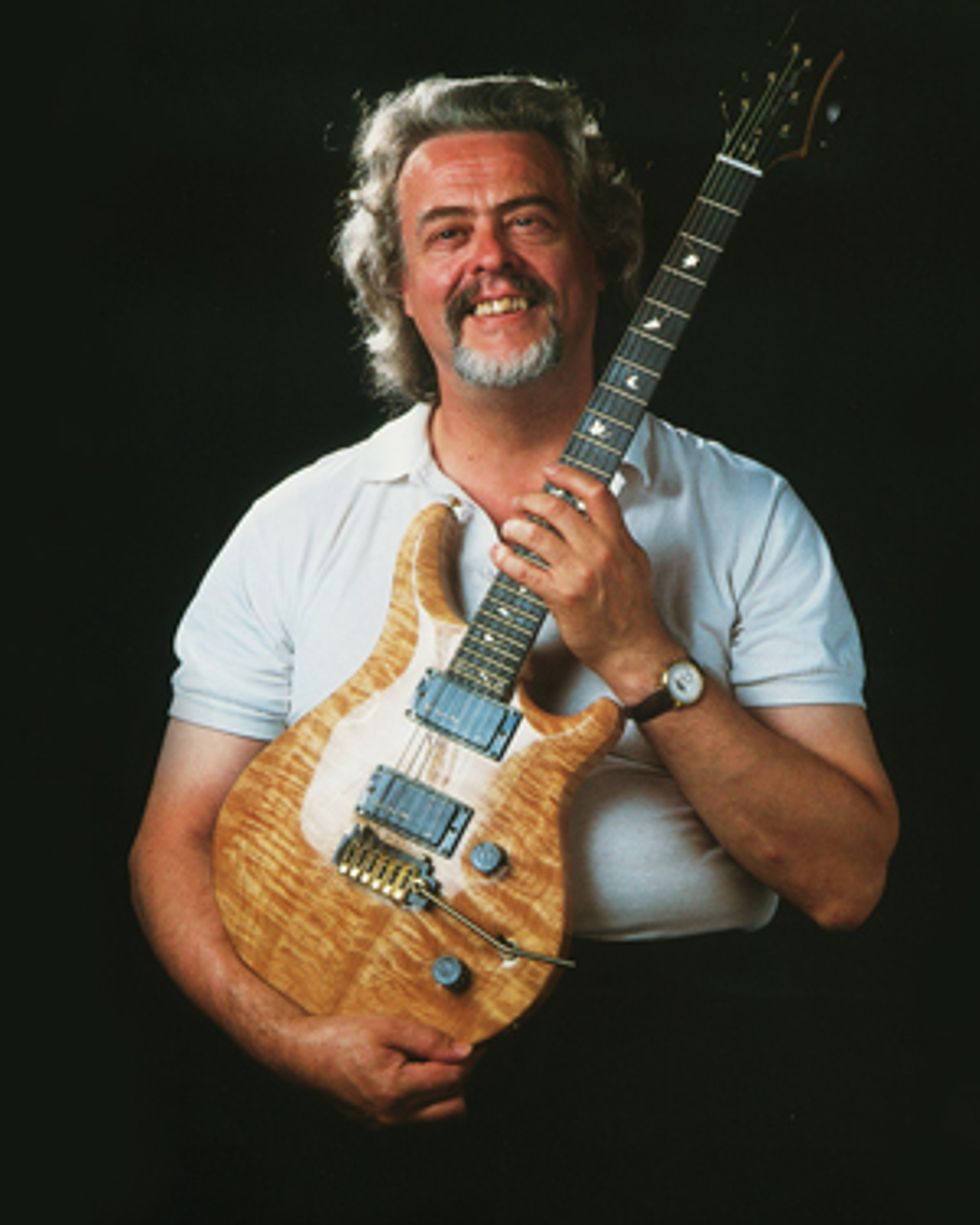
Big Jim Sullivan in the ‘90s with his Patrick Eggle JS Legend 001 signature guitar.
After parting ways with Jones in 1974, Sullivan hooked up with producer Derek Lawrence and together they created their own record label dubbed Retreat Records. Among the acts signed to Retreat were Chas & Dave, McGuinness Flint, and the American glam metal band, Angel. Sullivan thoroughly enjoyed his time as a producer for his own label, even if Angel gave him more than a bit of trouble. “That was a great experience for Derek and me. We had to get the bass player Mickey out of jail a couple of times, for wandering around hotels out of his brains. I remember Punky Meadows always carrying a pack of beers around with him. They were a great bunch of guys and we got on quite well considering the different planets we came from.” Ultimately the label lasted for two years before it folded, but by that point Sullivan had moved on again and was playing guitar in a band called Tiger.
Through its short history, Tiger consisted of Nicky Moore and Les Walker on vocals, Percy Jones and Mo Foster on bass, Simon Phillips on drums, Dave Lawson and Alan Parks on keyboard, and Sullivan on guitar. The band recorded three albums—Tiger, Goin’ Down Laughing, and Test of Time—to little commercial success, and their record label, EMI, refused to release their final album. Sullivan disbanded Tiger in 1978 and joined the James Last Orchestra, where he stayed for nine years. He then worked on composing music scores and television jingles. In the mid-1980s, Sullivan linked up with a fellow U.K. musician Willie Austen and began to hit the pub circuit.
“I think we opened new vistas in pub entertainment,” Sullivan recalled. “We always played to full houses and we got paid well doing it.” The duo toured together for 12 years, ultimately separating in 1997. But Big Jim wasn’t ready to call it quits just yet and eventually formed the BJS Duo with guitarist Doug Pruden and continued to play small clubs and pubs up until his final years.
In 1992, Sullivan was approached by independent guitar maker Patrick Eggle who produced a Big Jim Sullivan Legend Model using specifications provided by the guitarist. Big Jim prized this guitar for its versatility and used it almost exclusively for the rest of his life. The guitar itself bears many similarities to a Paul Reed Smith SE with an added Axon AX100 SB guitar-to- MIDI controller, which Sullivan appreciated for its ability to give him a wide range of sounds.
Big Jim Sullivan once said his whole life was about playing guitar. “I play what I want when I want, and I hope the listener gets as much pleasure listening to the music as I get playing it.”
People take up playing guitar for many reasons—fame, fortune, or to attract members of the opposite sex. Sullivan is truly one of those special few who played the guitar for the sheer love of the instrument. For years and years he toiled in various London recording studios, playing on some of the biggest hit songs of the ’60s to virtually no acclaim or recognition of his efforts.
Of course, none of that mattered to him. “I am a very lucky man,” he wrote on his website. “I am living my life with my hobby as my profession.” We should all be so lucky.
Must-Watch Moments
Session legend Big Jim Sullivan said that for him, music is like yoga—
a platform for self-exploration. If those words from a bona fide player aren’t enough to pique your interest, check out the following
videos that showcase the skills of a man who played on more hit songs than he could remember.
In this footage, Big Jim
Sullivan demonstrates his
classical chops on a solo jazz
instrumental.
Here Sullivan talks about different
approaches to playing guitar,
from scales to arpeggios and
chords, and even encourages
players to explore the “forbidden
zones” of a guitar’s fretboard.
On this gem of a jam session
from the Tom Jones show, Jerry
Reed and Big Jim trade rapidfire
licks on “Guitar Man,”
while Jones delivers rockabilly
lyrics. Check out Sullivan’s Tele
solo at 3:00.
In this verbal account of growing
up in U.K.’s early rock
scene, Sullivan talks about
dying his hair blonde for his
first gig with The Wildcats and
making more money than his
milkman uncle.



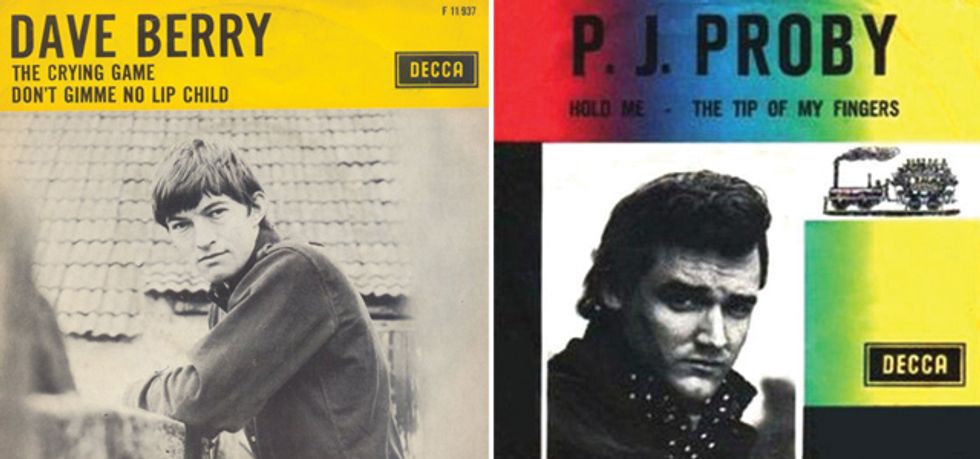
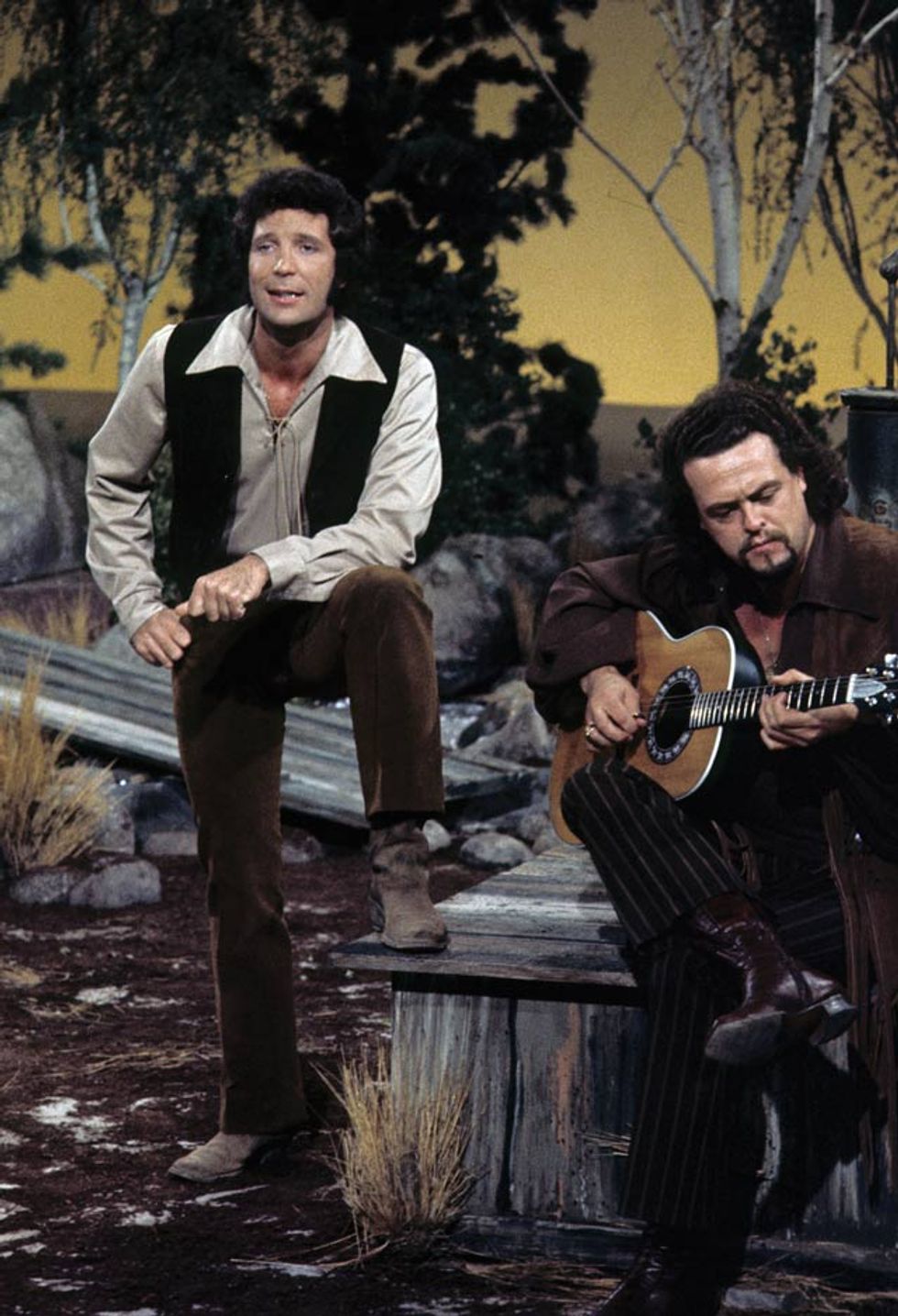

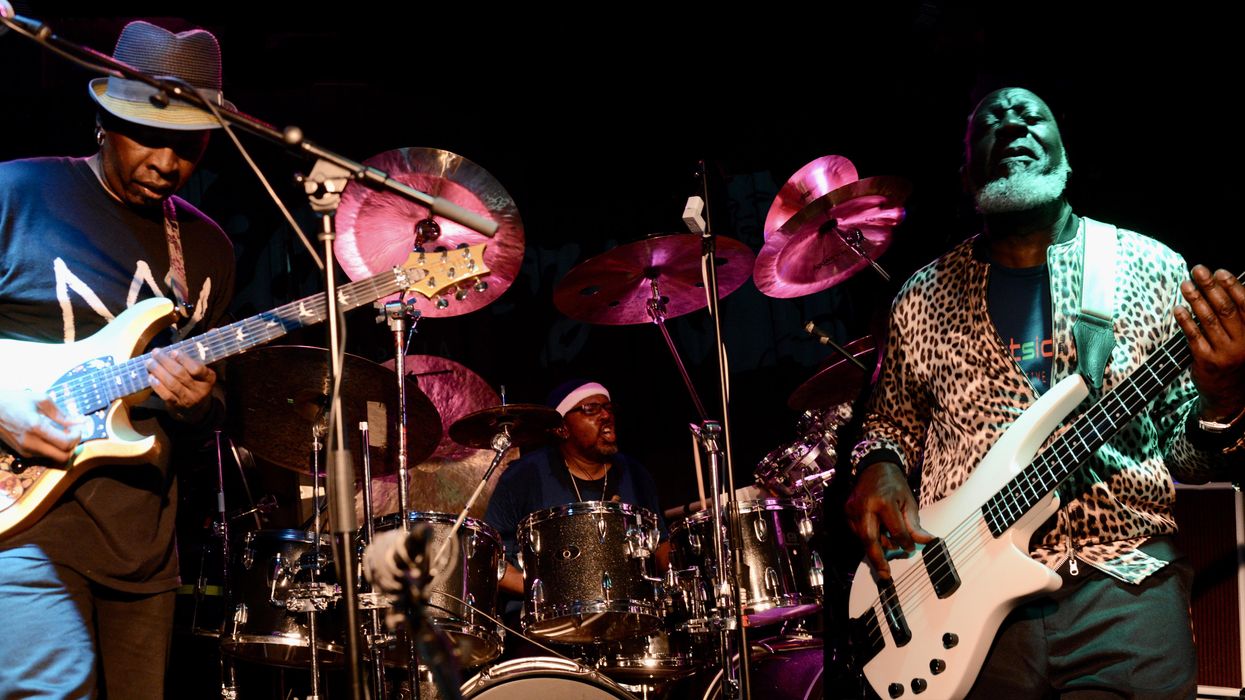
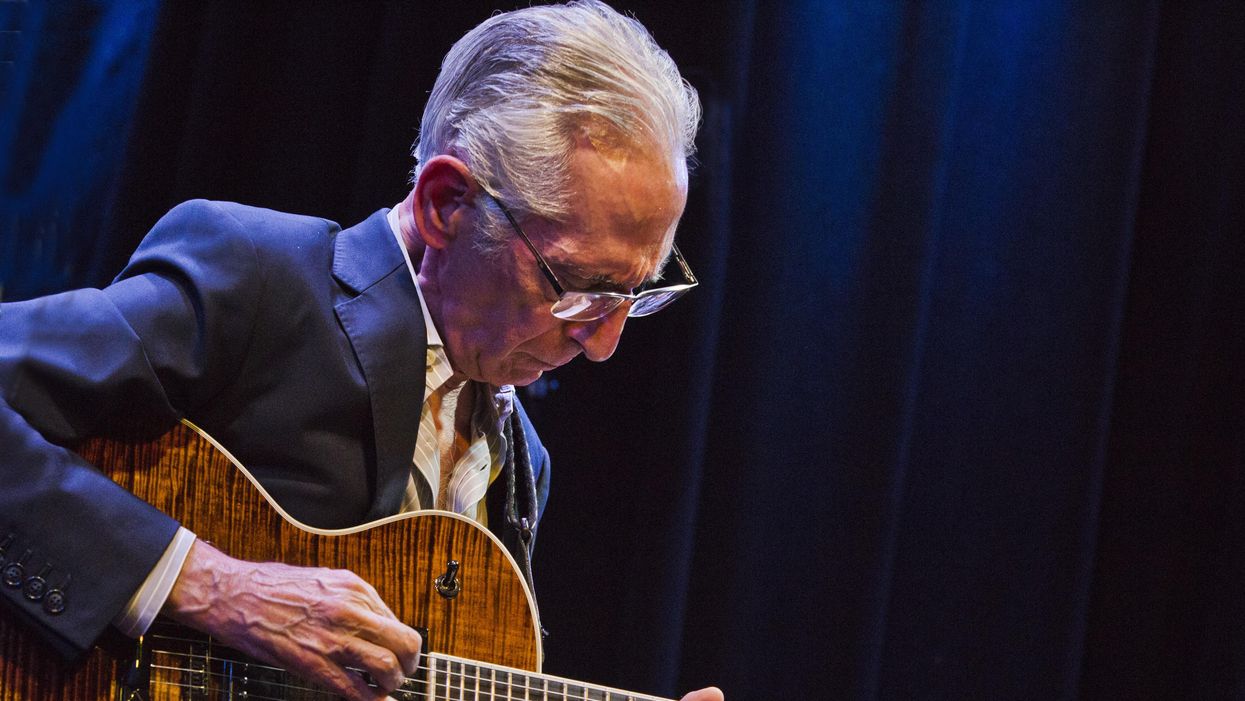




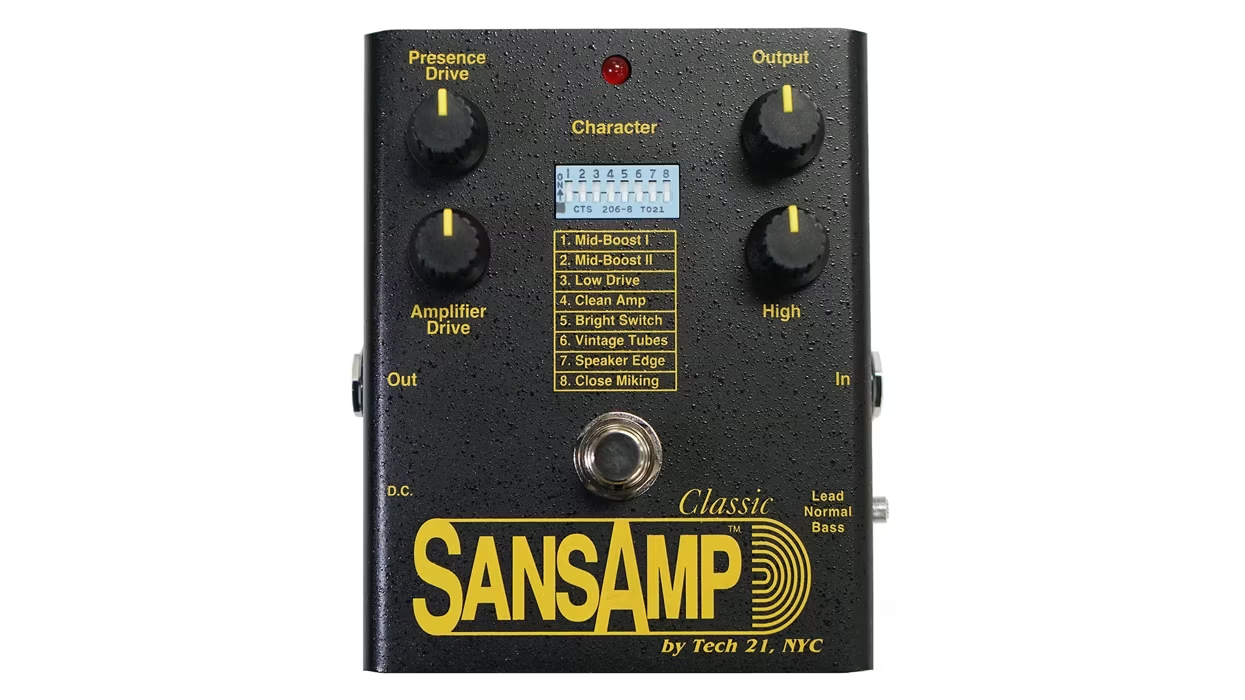
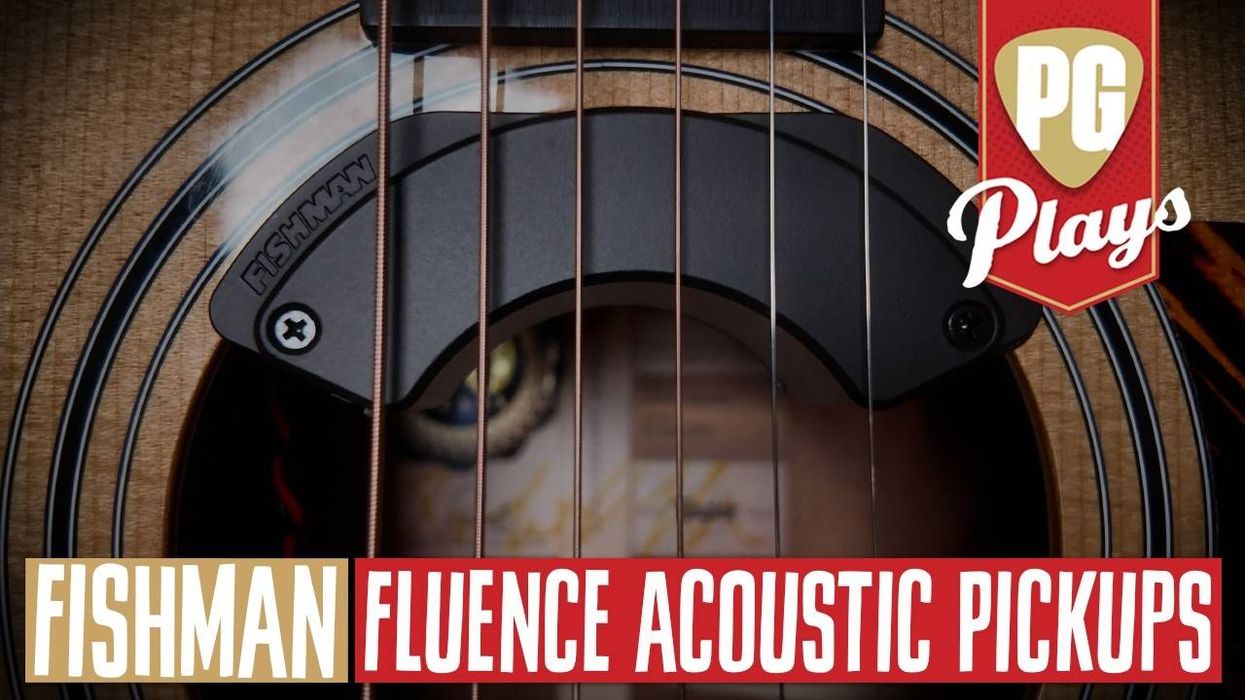
![Rig Rundown: Russian Circles’ Mike Sullivan [2025]](https://www.premierguitar.com/media-library/youtube.jpg?id=62303631&width=1245&height=700&quality=70&coordinates=0%2C0%2C0%2C0)
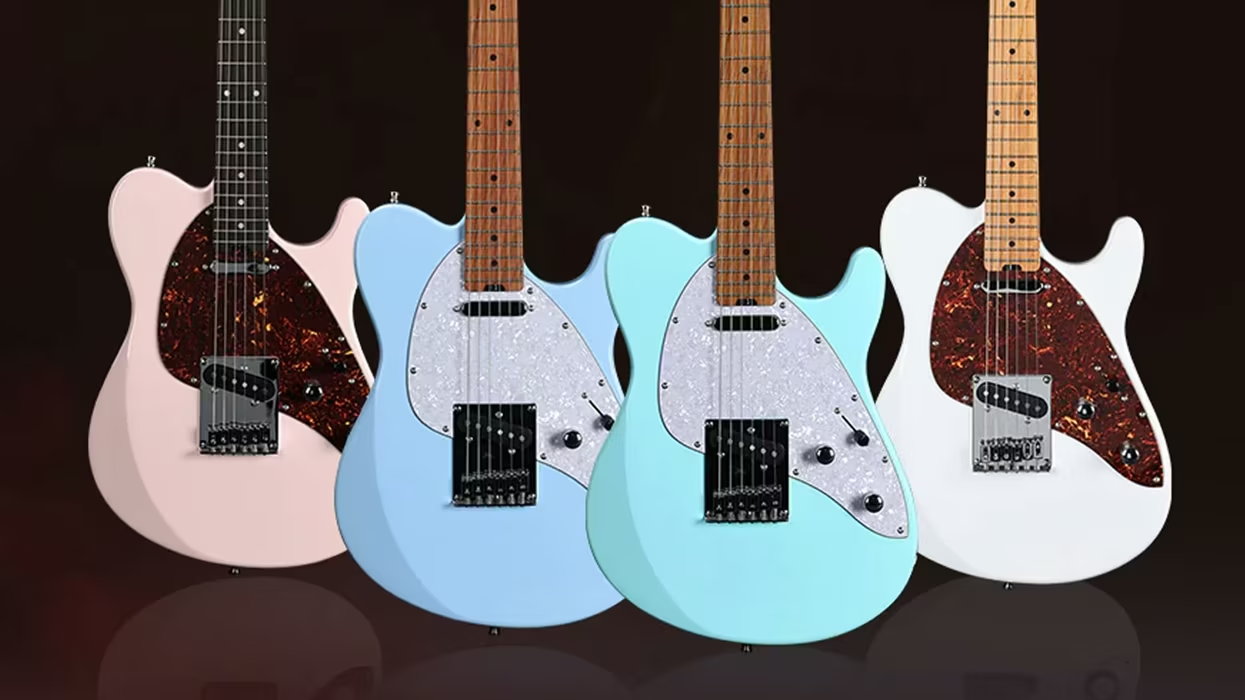










![Rig Rundown: AFI [2025]](https://www.premierguitar.com/media-library/youtube.jpg?id=62064741&width=1245&height=700&quality=70&coordinates=0%2C0%2C0%2C0)




















 Zach loves his Sovtek Mig 60 head, which he plays through a cab he built himself at a pipe-organ shop in Denver. Every glue joint is lined with thin leather for maximum air tightness, and it’s stocked with Celestion G12M Greenback speakers.
Zach loves his Sovtek Mig 60 head, which he plays through a cab he built himself at a pipe-organ shop in Denver. Every glue joint is lined with thin leather for maximum air tightness, and it’s stocked with Celestion G12M Greenback speakers.











